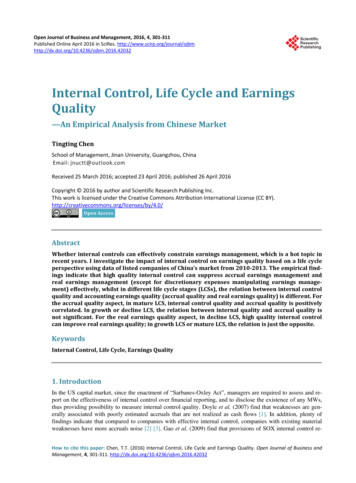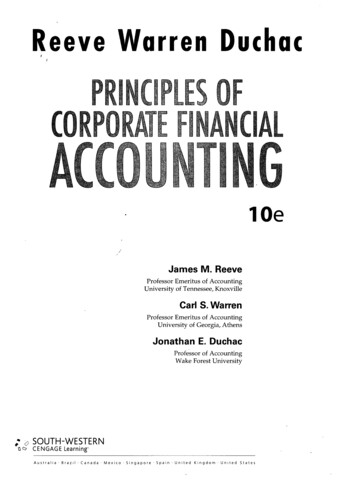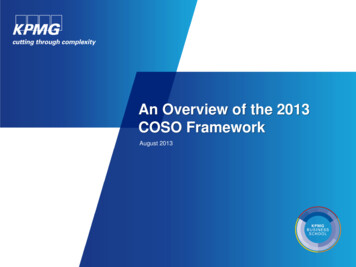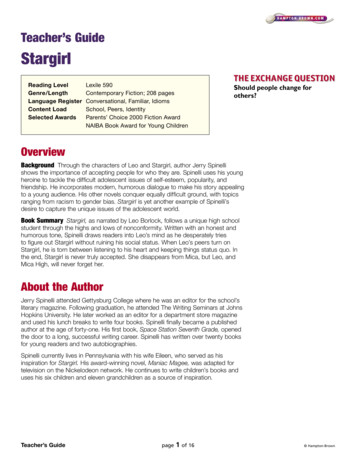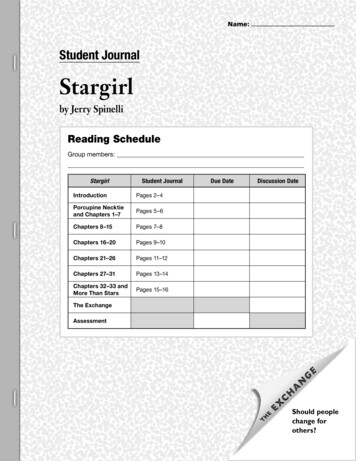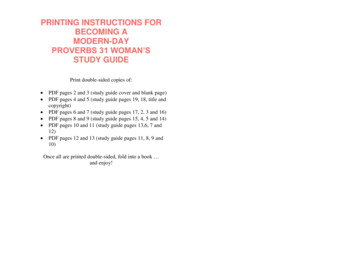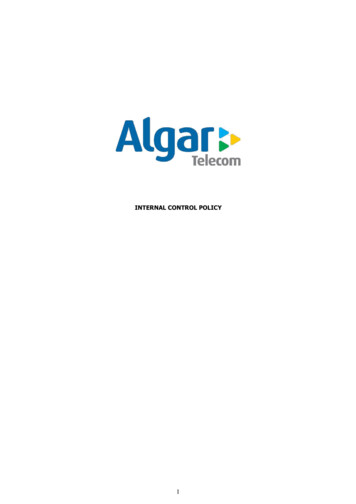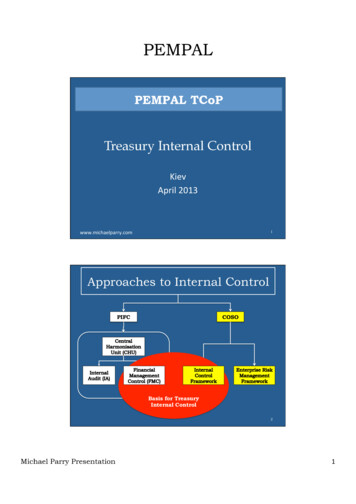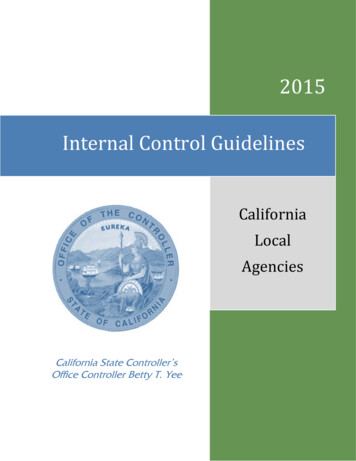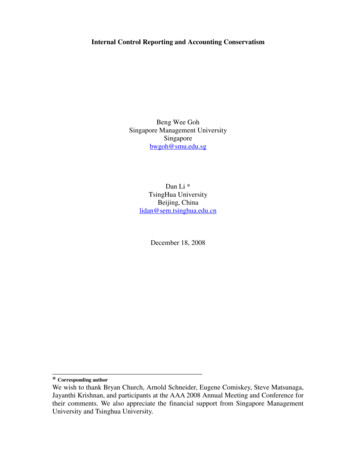
Transcription
TECHNICAL COMPETENCY DICTIONARYExplanatory NoteInternal ControlIntroductionThe National Treasury has developed a series of technical competency dictionaries (theCompetency Framework - covering the major occupational groups in the field of public financialmanagement. These dictionaries set out a series of descriptions of the skills and knowledgerequired of a competent practitioner in carrying out a number of standard tasks at various levelsof responsibility within the overall function.A total of 10 technical competencies dictionaries have been developed with the intention ofcontributing to human resource development in public financial management. This particularframework deals with internal control – a financial management discipline which is an integralprocess that is effected by a department’s management and personnel and is designed toaddress risks and to provide reasonable assurance that in pursuit of the department’s mission,the following general objectives are being achieved: executing orderly, ethical, economical, efficient and effective operations; fulfilling accountability obligations; complying with applicable laws and regulations; safeguarding resources against loss, misuse and damage.Developing the FrameworkThe internal control competencies dictionary was produced following a period of researchcarried out on behalf of the National Treasury under the Capacity Building Model for FinancialManagement (CBMFM) project. This research included the following: PFM related legislation, applicable regulations, instructions and practice notes, national and international standards and guidance on best practice, current practices applied in the workplace.The research was supported by consultative workshops with practitioners, who providedguidance on drafting the competency, and evaluated and commented on the competencystatements as they were developed. The attached technical competency dictionary representsthe outcome of that developmental process. However, this dictionary and explanatory noteremain living documents and will continue to be updated in the light of experience as they areused. Any comment on their contents and applicability is welcome, and should be submitted tothe Capacity Building section of National Treasury.1
Definition and ScopeInternal control operates as an integral part of the financial management activities in thedepartment. As part of this role, it normally reports to the department’s Chief Financial Officer.The responsibility of internal control is to identify, mitigate and manage control risks which mayhamper achievement of the Department’s objective to effectively, efficiently and economicallymanage its financial and related resources.The main functions performed by internal control cover the following areas: Manage effective, efficient and transparent financial (internal) control / inspectoratemeasures. Manage Loss control Manage financial and financial related systems Support with the management of Fraud prevention Maintain financial information and knowledge management Maintain governance frameworks Facilitate and participate in committees, forums and oversight bodiesThis dictionary however, deals only with specific internal control and loss control issues –matters pertaining to other financial procedures such as risk management, internal auditing,financial accounting and budgeting are dealt with in other dictionaries, though a number ofcompetencies in this dictionary do address aspects of engagement with some of thesefunctions. The dictionary is based on the functioning of a typical government internal controlactivity.AssumptionsIn order to carry out its role effectively, internal control has to be able to establish and maintain adegree of independence from the other financial management activities. Although part of theorganisational structure of the Office of the Chief Financial Officer, and reporting to the CFO,internal control needs to be able to exercise independent judgement about its operations whichpermit it substantially to determine its own work programme and express control risk opinionsfree from direct intervention by line management.The dictionary has also been designed on the assumption that internal control officials workingin national and provincial departments of government are subject to broadly the same workingpractices and work with common IT and other operational systems. At the same time it isrecognised that there can be variations in detailed practice between central and provincialadministrations, and between individual provincial administrations, so the specifications havebeen carefully drafted at a level of generality that ensures that such variations have beenaccommodated.2
The Internal Control Dictionary – Knowledge and SkillsThe technical competencies dictionary takes the form of a database containing two mainelements: the knowledge (and understanding) required to carry out efficient and effective internalauditing; the skills required to carry out efficient and effective internal auditing.However, the levels of skill and knowledge required vary substantially according to the level ofresponsibility of the individual employee in the organisation. To address this, both skills andknowledge descriptions are provided at four different levels.SkillsAll descriptions of skills required are offered in four tiers (occupational roles) which broadlycorrespond with the levels of administrative & technical (operational), supervisory (tactical) andmanagerial (strategic) responsibilities. Internal control activities are likely to involve staff atoccupational role 1 level in support functions, but such staff are not normally directly involved inprofessional activity and their skill requirements are primarily generic.KnowledgeThe actual knowledge required to support any competency is the same for all four occupationalroles. However, the depth of that knowledge, and the extent of underpinning understandingrequired varies according to the responsibilities being exercised. Therefore knowledgerequirements are also specified at four levels which broadly equate with the descriptionsworking, technical, in-depth and expert.It should be noted that whilst the level of knowledge and understanding specified in thedictionary generally escalates with occupational levels, there are instances where the level ofknowledge is not the same as the occupational level i.e. a greater or lesser depth of knowledgeis required than would normally be expected in that occupational role.More comprehensive details are provided in the attached Table 1.The Internal Control Dictionary – Competency DescriptionsThe knowledge and skills are listed against the principal components of the function. Thefunction is therefore broken down into a series of competency clusters which are high-levelsegments of the function consisting of one or more sub-components. Each cluster is thenbroken down into these sub-components – competency titles – which are the level at which thedefinitions of the skills and knowledge are provided.Each definition is supplemented by acompetency description which summarises the scope of the competency defined. Table 2(attached) contains a list of the competency clusters and competency titles used in thisdictionary with an indication in each case of the occupational roles to which they relate.Because of database limitations in the dictionary, general areas of knowledge (such as primarylegislation) and other regulations and guidance, some of this knowledge has had to besummarised, so a full statement of the knowledge required under these competency titles is set3
out in attached Table 3. This knowledge is applicable throughout the dictionary and is notnormally repeated at the competency title level. Knowledge statements at that level relate tomore detailed or supplementary knowledge required specifically for that competency, and areincluded in full in the technical competencies dictionary.Generic CompetenciesThe technical competency dictionary deals only with competencies that are specific to tasks infinancial management. However, many of the tasks carried out within the function covered inthis dictionary require more general competencies of a clerical, administrative or managerialnature. These generic, or core, skills are required for competence in many fields other thanfinancial management, and have therefore been defined in a separate core competenciesdictionary. In addition research has identified a number of behavioural competencies whichfurther supplement the technical competencies in this dictionary. Bringing all three sets ofcompetencies together will enable government financial managers to identify, understand andarticulate clearly the range of skills and attributes needed by staff at all organisational levels forthe competent discharge of their responsibilities.ConclusionThe Internal Control competencies dictionary, along with its nine companion dictionaries, marksa significant step forward for government financial management. Departments may apply itscontent to address issues in: recruitment and selection, staff training and development, performance management, career planning and succession management.4
Table 1 – Definitions of Terms Used in theInternal Control Activity (ICA) Technical Competencies DictionaryDescriptionCompetency ClusterCompetency TitleCompetencyDefinitionA brief description of the competency title.Skills RequirementSpecific KnowledgeRequirementKnowledge Level 1Knowledge Level 2Knowledge Level 3Knowledge Level 4Role DescriptorsRole 1AdministrativeRole 2TechnicalRole 3Supervisory (Tactical)Role 4Managerial (Strategic)DefinitionHigh level segment of the function.A short description defining the specific competency of thesub-component.Statement of the skills required within each occupationalrole and competency title.Specific knowledge requirements are noted that aredirectly related to a particular competency titleKnowledge DescriptorsRequires a working knowledge with a practical understandingapplied in straightforward circumstancesRequires a working knowledge with a good understanding appliedin circumstances of limited complexityRequires a thorough knowledge with an in-depth understandingapplied in complex circumstancesRequires an expert knowledge with a comprehensiveunderstanding to be applied in highly complex circumstancesRole DescriptorsExamples of Relevant PositionsClerkAdministratorSenior State AccountantState AccountantAssistant ManagerDeputy Director (Manager)Director (Senior Manager)Chief DirectorDeputy Director General5Post LevelsPost levels 1- 6Post levels 7 - 8Post levels 9 -12Post levels 13 - 16
Table 2 – Structure of the Internal Control Activity (ICA) Technical Competencies ompetencyTitleLegislative regulatory frameworkOccupationalRole 1 Departmental policies and procedures Integrated internal control systemInternal controlsystem Delegations frameworkAssurance services facilitationLoss ControlDepartmental loss control systemFinancial andfinancial relatedsystems controlsEffectiveness of financial and financialrelated systems controlsFraud PreventionDepartmental fraud Oversight andrelated committees OccupationalRole 2OccupationalRole 3OccupationalRole 4 Financial information retentionDepartmental Governance frameworks Departmental oversight and relatedcommittees6
Table 3 – General Knowledge Requirements for the Internal Control Activity (ICA) Technical Competencies DictionaryC.6 Regulatory and System FrameworkRegulatory FrameworkActsAdministrativeLineConstitution of the Republic of South Africa, 1996 (Act 108 of 1996)Construction Industry Development Board Act, 2000 (Act 38 of2000) and RegulationsDivision of Revenue Act ( an annual Act of Parliament)Employment Equity Act, 1998 (Act 55 of 1998)Government Pension Law 1996Municipal Finance Management Act, 2003 (Act 56 of 2003)Occupational Health and Safety Act, 1993 (Act 85 of 1993)Preferential Procurement Policy Framework Act, 2000 (Act 5 of2000) and RegulationsPromotion of Access to Information Act, 2000 (Act 2 of 2000)Promotion of Administrative Justice Act, 2000 (Act 3 of 2000)Public Finance Management Act, 1999 (Act 1 of 1999)Public Service Act, 1994 (Act 103 of 1994) and Regulations, 2001SARBARNEX Oxley ActSkills Development Act, 1998 (Act 97 of 1998)Borrowing Powers of Provinces Act, 1996 (Act 48 of 1996)Public Audit Act, 2004 (Act 25 of 2004)Disaster Management Act, 2002 (Act 57 of 2002)Finance Acts (annual)Inter Governmental Fiscal Relations Act, 1997 (97 of 1997)Provincial Tax Regulations Process Act, 2001 (Act 53 of 2001)Inter Governmental Framework ActGovernment Immovable Asset Management Act 2007 (Act 19 of2007)Local Government Municipal Property Rates Act, 2004 (Act 6 of2004)Prevention and Combating of Corrupt Activities Act, 2004 (Act 12 of2004)Foreign Corrupt Practices Act, 2004Financial Intelligence Centre Act, 2001 (Act 38 of 2001Prevention of Organised Crime Act, 1998 (Act 121 of 1998).Protected Disclosure Act, 2000 (Act 26 of 2000).7National Credit Act, 2005 (Act No 34 of 2005) and related BankingLegislation
RegulationsPapersPolicies, Frameworks, Programmes, etcTreasury Regulations, 2008PSA RegulationsCIDBA RegulationsProvincial Growth and Development Strategy, White Paper 2007OAG Practice NotesFinance InstructionsStandard Operating ProceduresBudget OverviewsExpenditure ReviewsFFC proposalsAnnual ReportsMonitoring & Evaluation ReportsQuarterly Performance ReportsTop Management MinutesMinisterial Top Management MinutesCabinet ResolutionsFinancial AgreementsBusiness PlansManualsNational Budget SpeechOrganisational and Government Structures5-year Strategic PlanMTSF (Government Priorities)Annual Performance Plans (APP)Published conditional grant frameworksPublished budget programme structuresCode of ConductGRAPGAAPEconomic Reporting FrameworkStandard Chart of Accounts (SCOA)Enterprise Risk Management Frameworks (National & Provincial)Budget guidelinesAnnual reporting guidelinesBudget CircularsStrategic Plan guidelinesApproved Revenue Tariff StructuresStrategic DirectivesMedium Term Budget Policy Statements (MTBPS)Public Service Anti-corruption Strategy and anti-fraud measuresFramework for managing performance informationNational Treasury Guide on the preparation of budget formats8
SystemsNational Treasury Guide on the preparation of the ExpenditureEstimates for the MTEFNational Treasury performance information guidelinesFramework for preparing SP and APPEPWP Incentive Grant FrameworkBasic Accounting System (BAS)VulindlelaLOGISPersal9
Public Finance Management Act, 1999 (Act 1 of 1999) Public Service Act, 1994 (Act 103 of 1994) and Regulations, 2001 SARBARNEX Oxley Act Skills Development Act, 1998 (Act 97 of 1998) Borrowing Powers of Provinces Act, 1996 (Act 48 of 1996) Public Audit Act, 2004 (Act 25 of 2004) Disaster Management Act, 2002 (Act 57 of 2002) Finance Acts (annual)

